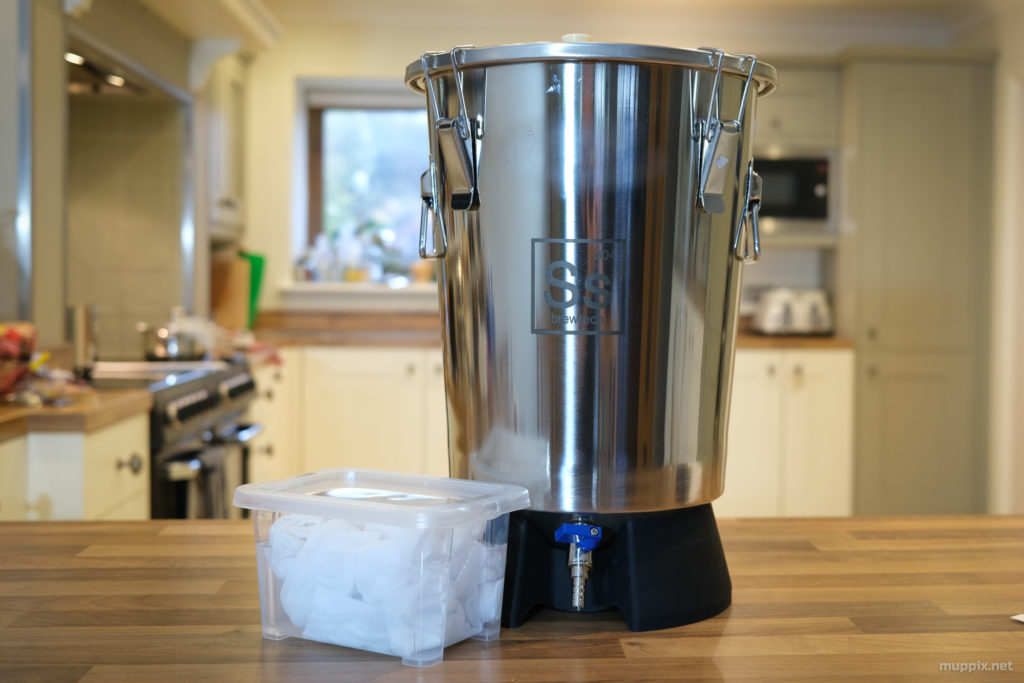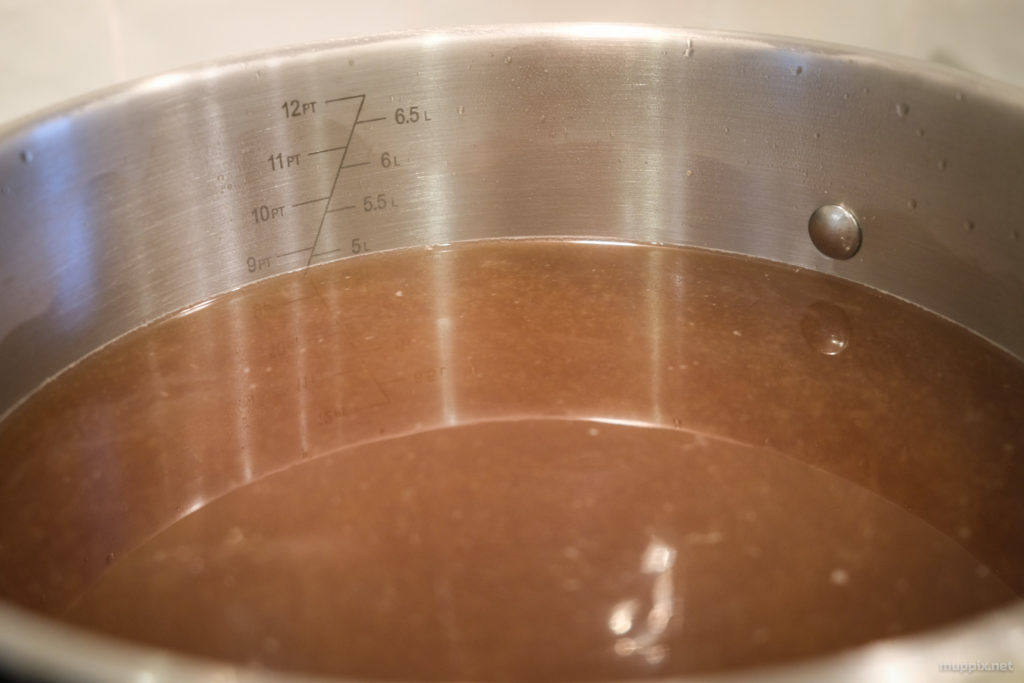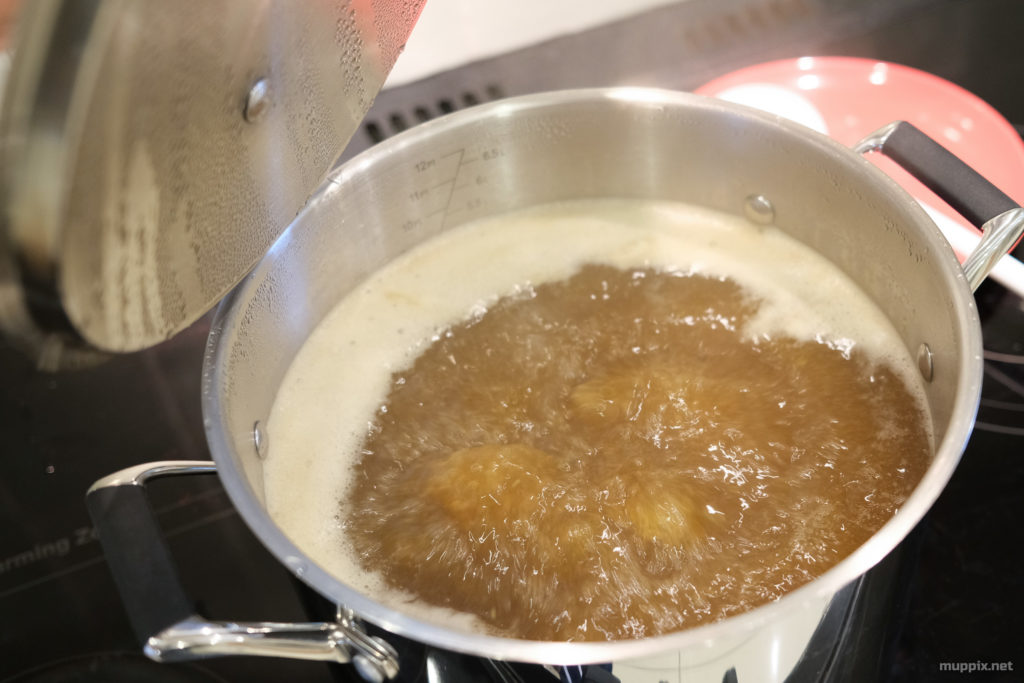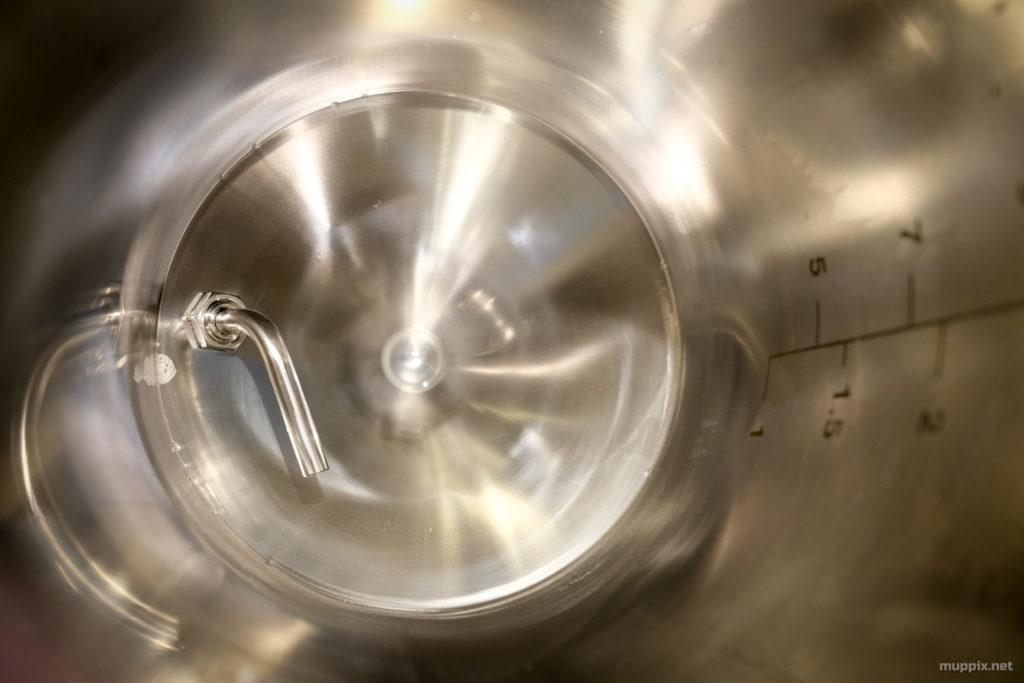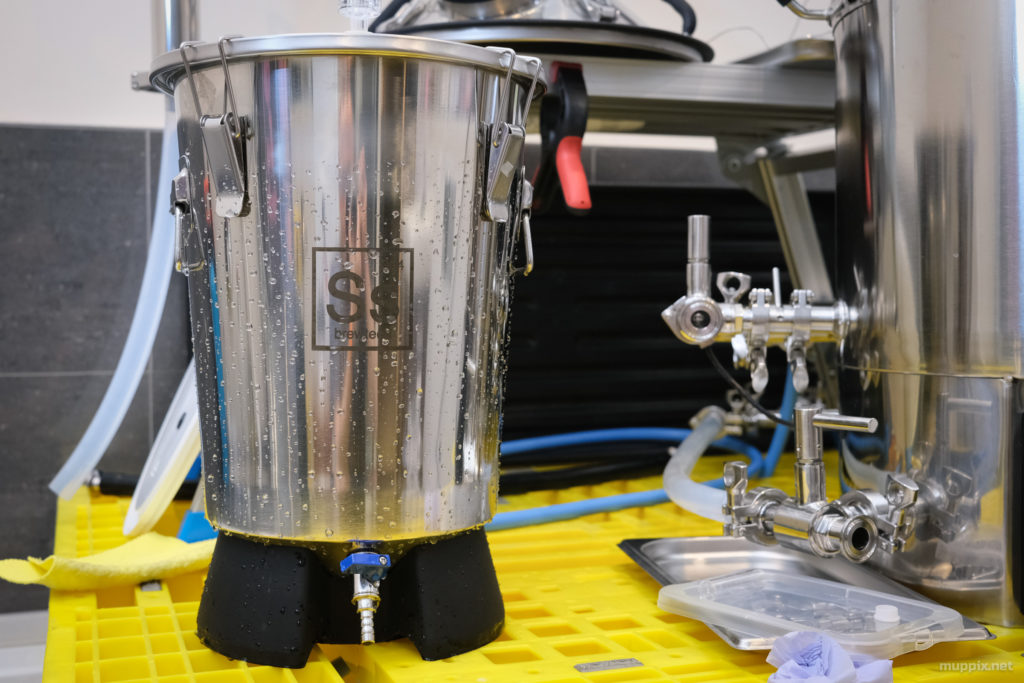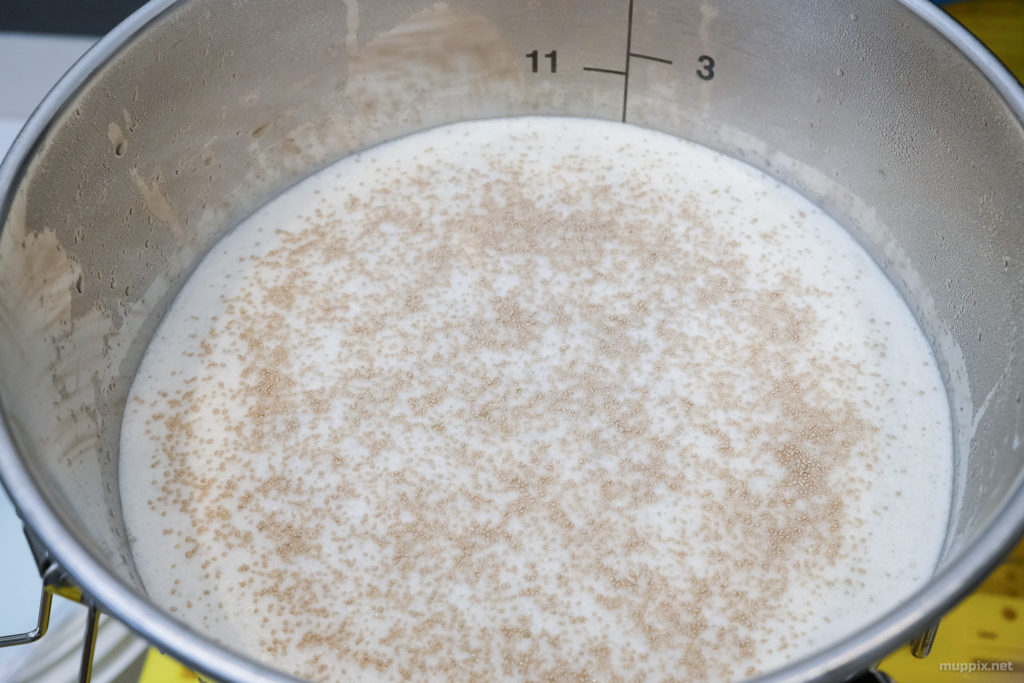I pulled 5 or six bottles into the fridge since they hadn’t really begun to clear in the garage, and the one I liberated hence looked exactly the same. Carbonation is OK but could just as well be dialled down 20%, taste is bitter with a very slight hint of twang. Mouthfeel smooth and pleasant without being overly complex, very good head retention. Another two weeks and this one will be almost as good as the kegged version.
Foxdale Gold
| Ref | 2021-03 Foxdale Gold | Brewer | Pain & Patience |
|---|---|---|---|
| Style | Golden Ale | Type | Beer, extract |
| Started | Thu 25th Mar 21 | Status | Archived, |
| Packaged | Fri 9th Apr 21 | Fermenter | SS 10 litre Bucket |
| Handle | 2021-03 Foxdale Gold |
|---|---|
| Brewer | Pain & Patience |
| Style | Golden Ale |
| Type | Beer, extract |
| Fermenter | SS 10 litre Bucket |
| Status | Archived, ABV |
| Started | Thu 25th Mar 21 |
| Packaged | Fri 9th Apr 21 |
Decided to crack open the mini keg of Foxdale Gold with some Chinese today, and what a treat! Really pleasant aroma of ripe hops, very fresh clean taste, hoppy, with a slightly bitter lingering finish. Comparing this to Second Extract Blonde (my preceding extract attempt) this has definitely got slightly more hops and a more flavoursome body. The only thing lacking is clarity, with even the second and third pint still quite hazy. She’s had 3 days of cold-crashing and 12 days in the (refrigerated) keg – shouldn’t it be a little clearer by now?
I moved the eight silver capped 500 ml bottles of Foxdale Gold into the garage today, they’ve been in the warm server room long enough now. Little bit of sediment inside and they’re still quite hazy, may take a long time to clear in the garage now that we’re into ‘summer’ with daytime temperatures of 10 ℃ and 3 or 4 ℃ at night. Bound to be a bit warmer than that in the garage though, so I’m thinking I may bring these into my new beer fridge when it arrives.
Took just over 24 hours to get from room temperature down to 4.0 ℃ in the brew fridge. I had that dialled to ‘med’ for the first half and then just below ‘max’ for the second as I didn’t want to freeze the 19 litre keg of Golden Wave that was already in there, nearing the end of it’s conditioning phase. Three days later I’m ready to put this, my third extract brew, into final packaging.
I don’t want to tie up both 5 litre mini kegs and also put some bottles away to share, so it makes sense to try and guess the number of bottles I could fill while also using as much of one keg as possible. In the end I went for 8 x 500 ml silver crown-caps and hoped for a nearly-full keg to allow room for carbonation, but realistically kegged somewhere between 3.5 and 4 litres.
For the bottles I used the Blichmann Beer Gun again, and thinking about it this may have been it’s first outing with actual beer. I set the SS Brewtech Mini Bucket onto the lab platform (plastic palette over the bath) and relied on gravity to pull liquid through my Bouncer filter from the bucket’s spigot and into the beer gun. Even with this modest drop in elevation the flow was enough. Gas was routed to the beer gun via one ⅜ line with another feeding Bag Thing on top of the bucket behind a John Guest tap and T-piece. Absolutely no flaws in setup here; both gas and liquid being delivered efficiently even if I did forget to purge the filter with CO2 before starting. Oops. Each bottle was primed with 5 ml of dextrose – conveniently using a baking measuring utensil I found in the kitchen. Hopefully it’s near the 3.3g that I need for 2.4 vols, according to the calculator. She’ll be right.
Once bottling was done I was about to start rigging up the necessary equipment to fill a 5 litre mini keg with sanitiser and then flush it with CO2 when I realised that, actually, this is just a really big bottle which will get drunk as soon as it’s carbonated in a week’s time. I still had the beer gun set up for bottling so I just used that, giving the keg a decent blast of gas and then filling it until I started seeing bubbles coming from the bucket. I couldn’t remember how low the dip tube was set and was keen to try my new filter, so I gave the spigot a clockwise turn until it started drawing liquid again. One or two lumps could then be seen making their way towards the Bouncer but not beyond, so I kept fiddling with the spigot until no amount of turning would result in more beer. That’s eight bottles and almost a 5 litre keg. Nice one!
We’re back at 1.014 as we were six days ago despite the occasional emission from the airlock, and the sample from the trial jar is lovely. If the escaping CO2 isn’t going to lower the final gravity then I’ll be damned if I’m letting it rob me of hop goodness, so let’s get this is in the chiller and drop out some of that annoying cloudiness.
I wanted to include my new thermometer’s remote sensor by sanitising it and using it into the beer via the same stopper that’s connecting Bag Thing, but can’t count on that being a really good seal so I’ll just have to wait until I add a proper thermowell to the SS Mini Bucket.
Meanwhile I’ll see if I can get any kind of sense from the remote probe by taping it to the side of the fermenter, and insulating it from the rest of the fridge with a thick piece of foam.
Been 5 days since the last look at this, has it stopped fermenting? Possibly. Gravity is unchanged if anything, having gained a point to 1.015. There’s practically no airlock activity now, just the odd bubble here and there, and while I’m tempted to give it another couple of days I don’t think it’s going to change. We’re 4 points off Brewfather’s predicted FG of 1.011 and will have to settle for 3.4% ABV instead of 3.9%.
Let’s think about finishing hops. The last extract of this size got 25g Citra, this time I’m going to add 15g of Falconer’s Flight and 20g Citra, for no reason other than balancing my inventory.
I’m itching to get this one dry hopped and to start cold-crashing but there are still sporadic signs of fermentation, even if it’s just the airlock popping once every couple of minutes. Gravity checks in at 1.014 and the sample drawn from the Mini Bucket’s ball valve reads 19.1 ℃ with the adjacent ambient temperature at 18.9 ℃ so very minimal increase through activity.
The sample in the trial jar is extremely hazy and shows slight signs of carbonation, taste is a little yeasty but with a clean finish despite the filmy residue on the glass. Plugging the values into Brewfather (I need more Tilts!!) shows I’m 90% done at 3.5% ABV, so I need to let this ride for a few more days before I dry-hop some flavour into her.
There were some irregular pops from the airlock an hour after pitching yeast, and by next morning it was popping once every couple of seconds. This is a good sign as I was beginning to wonder if half a packet of yeast was enough at this batch size, but I’d aerated well and if one whole packet is OK at 20 litres then we should be fine here with 5 grams.
The Mini Bucket has been sitting on the window sill where it’s 17 – 18 ℃ during the day and 16 ℃ overnight. The variation isn’t great, I’d much rather have a constant temperature, but until I get a brew fridge set up I’ll just have to make do with this. On the positive side I know that the bucket is a fairly solid lump and any changes in room temperature will take their sweet time to come into effect.
At any rate the temperature inside will be a couple of degrees warmer than the outside if this is anything like the fermentation undergone by Golden Wave, which has been all over the place despite a fairly constant room temperature. Early this morning I noticed some condensation in the inside of the airlock which backs up my theory that it’s warmer inside than out.
Another extract brew, this time starting out in Brewfather by picking a style and seeing what’s possible with the same amount of LME as my previous two extract brews. The only differences this time around are a departure from Blond Ale (18A) to British Golden Ale (12A) and the addition of some steeped grains before the boil.

As usual there were some unplanned events throughout the afternoon and plenty of opportunity for thinking on the fly. Raw notes are below; I’ll highlight any noteworthy bits and will insert pictures as they were taken, this time using my Fujifilm X100V.

Brew Day Notes
- Weighed out ingredients, almost forgot the yeast!
- I didn’t have any Centennial hops as planned, these must have been added to the inventory when I ordered them and they’ve not been delivered yet. I need 5g for dry hopping so I substituted that for Citra instead. Can always change that back if I get my shipment in time.
- Plan to use two nylon strain bags, one for steeping and another one waiting in the FV when I transfer. Give them a thorough clean and then boil for a few minutes to try and get rid of the awful plasticky smell, but it’s still there. Hope the brew won’t be affected.
- Very difficult to get temperature right for the steep. I’m aiming for 75 ℃ but the new thermometer with remote probe I’m using is all over the place, reading between 50 and 90 ℃ depending on where in the steep I poke it. Being paranoid I add some more cool water in order to avoid tannins, steep at around 72 ℃ for the best part of half an hour while preparing the FV. Later figure out that the thermometer is actually very accurate and has a high refresh rate.
- Grains finished steeping after 30 minutes, lift the bag out and give it a gentle squeeze.
- Pour grain juice into big saucepan, add 600g of LME, top up to 4.89 litres (give or take). It’s occurred to me that pre-boil volume is shown as 4.89 and then there are the 60 minute additions of LME and hops, with boil volume still 4.89. I take it that includes the 60 minute additions of hops and LME.
- 97 ℃ and seeing some foam, about to boil and start timer. Is this the ‘hot break’?
- Figured out that I had left the initial 600g of LME as a 45 minute addition, not a 60 minute addition. Originally the recipe was for 45 minutes, but I didn’t think that was long enough to isomerise the hops properly so I scaled it to 60, forgetting to change the timing of the LME addition. Oops. Updating the recipe on the fly causes IBU and BU/GU sliders to move quite far to the left, so I move them back by increasing the 5 minute addition of Cascade from 5g to 23g – was going for 20g but there seemed little point leaving 3g in the bag.
- A nice rolling boil turns into a small boil-over, costing me a little bit of wort loss. Arse – I was hoping to accurately measure 60 minute boil-off rate and update the equipment profile, which I now can’t do unless I expect to have a boil-over each time I try an extract brew. Day’s turning into a bit of a nightmare!
- Thinking ahead a bit, I’m not sure how to best get the temperature down from flame-out to 80 ℃ for the hop-stand. Maybe throw some ice cubes in and subtract those from the fermenter top-up volume? At least that should be a constant @ 8 litres total.
- Clean the steeping bag while the boil is going on, and it’s a right pain with bits of chaff getting stuck everywhere. In the end I resort to rinsing it both sides twice then taking it outside and flicking it for 5 minutes, occasionally picking at the bits of crap.
- As I fit the second sanitised strainer bag to the SS Brewtech Mini Bucket it occurs to me that there’s little point filtering out crud now when I plan to dry-hop later, but I press ahead with the plan anyway. At least the boiled hops won’t be in there to have an effect on the yeast, if they even would.
- Added 5 minute hop additions and LME, and boil volume now looks like 5 litres bang-on. (so I couldn’t have measured 60 minute boil-off anyway) Bit of a worry, since the recipe said post-boil volume should be 3.39. Maybe I should have boiled with the lid off most of the time? I now need only 2 litres of fermenter top-up, not 5, if I am to stick to the original 8 litres. But I have capacity for 10. May decide which way to go once I’ve done the hop-stand and taken a gravity reading.
- Stirred in 2 trays of ice cubes, crossed my fingers, and for once I’m exactly where I need to be at 80.3 ℃. Yes!! But it’s going to take more than 2 litres of iced water to get this to pitching temperature.
- Post-boil gravity is 1.066 at 70.5 ℃, which calculates to 1.089. Brewfather was expecting 1.109 so I’m only a little way off… by 20 points.
- Transfer to FV and wow – there’s a lot of crud in that strainer! Glad I pulled it out. Top up to 8 litres approximately and measure OG at 1.043 / 36 ℃ which translates to 1.048.
- The Brewfather thinks I should be at 1.041 so I’m topping up the fermenter to the 9.5 litres mark, using all my iced water but still only getting to 32 ℃. Gravity now reads 1.038 which calculates to 1.041, exactly what I need. Excellent! But I’ve diluted the various fermentables to 9.5 litres, which I still need to reflect in the recipe somehow. Not to worry for now, I’m fitting the air-lock and getting this into the fridge ASAP so that I can pitch yeast at 20 ℃.
- I’ve been clearing up for half an hour and the brew has only dropped one or two degrees. The fridge is cold but air is a poor thermal conductor, so I’m doing something unorthodox and putting the stainless brew bucket into an iced water bath. It’s a shameful way to treat such nice piece of kit, but I have to get this down from 31 ℃ soon.
- Down to 21 degrees in 17 minutes – impressive! I’ve rigged up my air stone to one of the oxygen cylinders from my inline aeration kit, and bodge the join (waiting on parts) with gaffer tape. Seems to hold, so I’m going to give this wort a taste of oxygen before pitching the yeast.
- Aeration stone is a really cool piece of kit with a surprising amount of back-pressure. Adding pressure via the regulator I was worried my gaffer tape wouldn’t hold, when the stone suddenly sprung to life and started giving my brew a nice foamy head. I let it run for maybe a minute before pulling it out, then pitched half a packet of Cross My Roof yeast (same amount as last time) onto the foam at 20.6 ℃ before putting the lid on and setting it aside. Finished at 18:30.



















